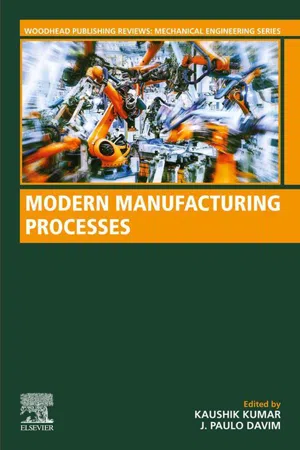1.1 Polymer matrix composites
Composite materials are produced by stitching dissimilar materials that have diversified properties. The constituent materials function as whole unit that offers composite material of unique properties. Composites are made up of one continuous phase and one or more discontinuous phase. The discontinuous phases are mixed and uniformly distributed over the continuous phase. The continuous phase is called matrix. The material rigidity, environmental resistance, and hold up of discontinuous phase are the main functions of matrix. Metals, polymers, and ceramics can be used as matrix material. The discontinuous phase is called the reinforcement which gives mechanical strength and stiffness to the composite material. Materials of fibrous form, particle fillers, and whiskers can be used as reinforcements for the composite material.
Polymer matrix composite (PMC) material uses either thermoplastic material or thermoset resin as the matrix and mats of glass, carbon, etc., as the reinforcement. On functioning, these resin matrices distributes the load among the each fibrous units and protects the fibrous mats from physical damage on application due to wear, abrasion, and impact. PMC’s offer unique and superior characteristics such as higher mechanical strength, material stiffness, better environmental resistance, and easy formability in terms of molding processes. Importantly, superior characteristics are obtained along with low density and higher strength to weight ratio, which makes a first choice compared with usual applied materials in many applications [1].
Light weight coupled with higher strength and tailor-made properties make them suitable for more advanced applications such as bullet trains, aircrafts, satellites, and submarines. Recently, focus shifts to apply PMCs in automotive, transport, consumer, infrastructure, and sporting goods because of their advantages such as integrated component production with lower assembly costs. However, the installation of PMCs to automotive, transport, infrastructure, consumer, and sport industries has been slowed due to the lack of understanding of production process, the lack of validated experimental and raw material characteristics information, nonavailability of material design facilities, nonavailability of proper procedures and guidelines, and limited hands-on experience. Thus the successful and economical fabrication of a composite component requires a proper product design and manufacturing facilities [2].
Depending upon the type of polymer matrix used, PMC’s are classified into thermoplastic PMC and thermoset PMC. Thermoplastic PMC currently represents a relatively small part of the PMC industry. Thermoplastic PMC are prepared using heat and pressure and there is no chemical reaction process that occurs during processing. The thermoplastic matrix is supplied in solid form and the thermoplastic PMC is formed by inserting the reinforcement material into the molten thermoplastic matrix. The production of thermoplastic PMC’s are difficult because of higher melt viscosity of the thermoplastic matrix. However, thermoplastic PMC’s are prepared with filler, powder, and short fiber reinforcements using injection and extrusion moldings. Recently, long fiber thermoplastic composites manufacturing methods have been developed with the (1) injection and extrusion of relatively long fiber filled pellets of thermoplastics, (2) reinforced reaction injection process, (3) coating of thermoplastics on long fibers coupled with thermoforming, and (4) pultrusion of long fibers into the thermoplastic matrix [3].
The thermoset PMC uses a thermoset resin as the polymer matrix. Thermoset resins can be cross-linked and converted to hard solid using a curing agent or an application of heat. This cross-linking operation is called curing. The thermoset PMC is formed by impregnating the resin onto a reinforcing material, followed by a curing step to produce the finished part. Thermoset resins are initially available in liquid state and hence it is easy to introduce the inserts like fillers and reinforcement fibers.
Polyesters, epoxies, phenolics, polyurethanes, and polyimides are some of the commonly used polymer matrix systems to produce a composite material. Among them, unsaturated polyester (UP) resins are the commonly used resin system in most applications due to its low price, curing nature, and its improved characteristics toward chemicals. UP resins are pale yellowish viscous liquid containing polyesters mixed with styrene monomer. Styrene reduces the viscosity of the UP resin solution and it helps in cross-linking process, which makes the liquid resin to rigid solid state.
Reinforcement fibers are fine diameter one-dimensional elements with a fairly large aspect ratio. The most common reinforcements are glass, carbon, aramid, and boron fibers. More than 90% of composites made uses glass fiber because of its all-round properties and relatively lower cost. The glass fiber is commercially available in the forms namely yarns, rovings, chopped strand mats, chopped strands, and woven rovings. Each of these forms has its own special application. Yarns and rovings are continuous fibers used in composite production processes such as filament winding and pultrusion. Chopped strands are used for making injection and compression molding compounds. Chopped str...
